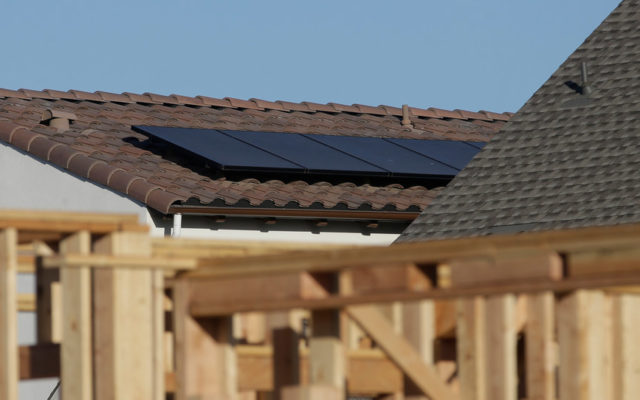
Offers to lower Maine customers’ power bills through solar might not pan out
By Sawyer Loftus, Bangor Daily News Staff
A growing number of companies are pitching the benefits of community solar projects to electric customers looking for a way to reduce skyrocketing bills. They allow ratepayers to subscribe to a share of the power from new solar installations, so they can receive bill credits once a project is online.
But community solar projects in Maine aren’t a promised cost saver. There’s a good chance many of the hundreds of projects that have been proposed in the three years since Maine opened the door to community solar won’t be built, as they wait in a long queue to connect to an electric grid that’s not set up for a proliferation of smaller-scale solar projects. And recent changes to Maine’s community solar program have left its future uncertain.
Legislation that passed in 2019 opened the door to community solar project proposals from both in-state and out-of-state solar developers. The state has seen developers propose more than 600 projects across the state since then and request to connect them to the electric grid.
But legislation passed last year has effectively stopped that flood of new proposals, as the legislation limited the size of projects that could participate in the community solar program and instituted new requirements for those projects, such as a signed agreement with either Versant Power or Central Maine Power Co. to connect to their distribution network.
Those agreements often aren’t reached until the utilities have studied new projects’ effects on their systems’ infrastructure, which can often take years. And last year’s legislation put new requirements in place retroactively for projects that were already in the works.
There’s agreement among developers, utilities and the state’s top advocate for ratepayers that the program has a number of problems.
“This has just become such a mess,” said Tyler Adkins, who established Monson Community Solar, Maine’s first community solar project, which supplies power to 24 homes and businesses in the Piscataquis County town near the Appalachian Trail.
“I think at the end of the day, what I’m most frustrated about and kind of ashamed of is that the people who are supposed to be representing our interests here either don’t know what they’re doing or they’re not asking the right people for help.”
One problem for Maine Public Advocate Bill Harwood is that the utilities buying power from new solar installations have to pay for their power at a steep retail rate. There could be some benefit for the ratepayers subscribing to the community solar installations, but a cost that the utilities’ other ratepayers have to absorb, he said.
“I think at this point we can get solar power at five cents a kilowatt hour and to pay 20 cents means that ratepayers are paying more than they need to,” he said. “And if we don’t get this under control quickly, the costs will escalate.”
For customers who subscribe to a community solar project, the benefit isn’t clear cut, either, Harwood said. The amount they receive in a rebate can be complicated, as it depends on an agreement they sign with the solar developer that’s not subject to regulation. The agreement often saves more of the rebate for the developer than the customer, he said.
Associations representing solar developers, such as the Coalition for Community Solar Access and Maine Renewable Energy Association, praised the changes made in last year’s legislative session.
But Adkins, who is also chief revenue officer for the New York-based company UGE, a solar company with a number of pending projects in Maine, said the changes have made development more difficult.
“I’m embarrassed at how all the community solar stuff has rolled out in Maine just because it demonstrates a lack of understanding as to how the grid works, how benefits and costs are distributed across the system, and what the purpose of all this is,” Adkins said.
One challenge is that it’s difficult to get utilities to share electricity consumption information for the individual customers subscribing to community solar projects. That means the companies might base rebates on inaccurate power use information, which can cost customers more.
“It’s impossible to reconcile the energy generated versus the energy consumed by the customer,” Adkins said. “This is an area where Maine is lagging behind other states.”
Utilities are feeling the heat as well, as they have queues of hundreds of solar projects — whether community projects or residential rooftop arrays — seeking to connect to their grids,
Solar power can’t just immediately be added to the electric grid, said Dave Norman, a Versant manager of regulatory support.
The delays developers encounter in connecting their projects to the grid often stem from extensive studies Versant has to do to determine each project’s effect on the rest of the system, Norman said. A proliferation of new projects could at times deliver too much power and overwhelm the region’s electric grid, he said.
That means broader fixes are needed with the state’s electric infrastructure, he said.
“Interconnecting large numbers of distributed generation projects on small, rural systems presents a number of challenges, but Versant Power is committed to working with developers to meet and overcome these challenges,” Versant spokesperson Judy Long said.
A new group created by the solar legislation passed last year is charged with outlining next steps for the community solar and other renewable energy programs and weighing updates to the state’s electric grid.
The group prepared an initial report in December and is continuing to meet this year, said Dan Burgess, director of the Governor’s Energy Office.